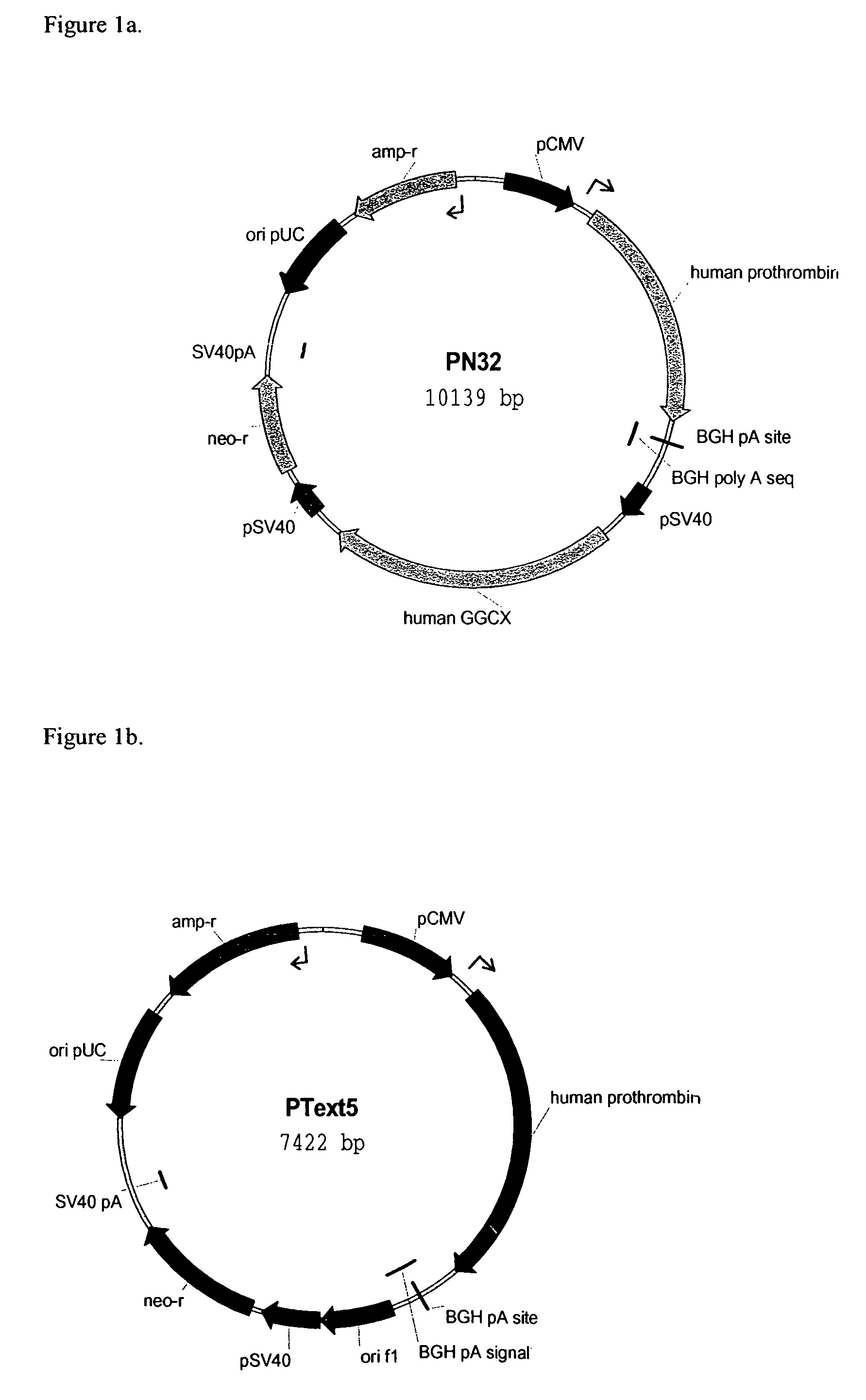Methods for producing gamma-carboxylated proteins
a technology of gamma-carboxylated proteins and gamma-carboxylated proteins, which is applied in the direction of peptides, enzymology, drug compositions, etc., can solve the problems of common clinical problem of bleeding, and difficult or even impossible purification process, etc., to promote increased or decreased coagulation
- Summary
- Abstract
- Description
- Claims
- Application Information
AI Technical Summary
Benefits of technology
Problems solved by technology
Method used
Image
Examples
example 1
Amplification of cDNA Encoding Human FII (hPT) and Human GGCX
[0097]Human liver mRNA was purchased from Clontech and cDNA synthesis was performed using the Superscript system from Invitrogen. The obtained cDNA was used as template for amplification of human FII using:
[0098]
primer PTF0(SEQ ID NO: 3)5′-ATTCCTCAGTGACCCAGGAGCTGACA-3′,andprimer PTEXT(SEQ ID NO: 4).5′-CTACTCTCCAAACTGATCAATGACCTTCTGTATCCACTTCTT-3′,
Human GGCX was Amplified Using
[0099]
primer hglx5,5′-TCCGCAGAGCAATGGCGGTGTCT-3′,(SEQ ID NO: 5)andhglx3,5′-CCAACATCTGGCCCCTTCAGAACT-3′,(SEQ ID NO: 6).
[0100]The FII-encoding PCR product was cloned directly into the TA-TOPO treated vector pCDNA3.1V5 / His (Invitrogen). Selection of a clone with hFII cDNA inserted in the correct direction gave the Ptext5 control construct (FIG. 1b). GGCX encoding cDNA under the control of the SV40 promoter was obtained by transfer of the GGCX encoding fragment from pCDNA3.1V5 / His TA-TOPO to the pZeoSV2+ vector (Invitrogen), using restriction enzymes BamH...
example 2
Measurement of ggcx Activity in CHO Cell Lines
[0108]Two rhFII producing CHO-S cell lines, obtained by transfection with the PN32 construct (co-expression of human GGCX) and PTEXT5 (no co-expression of GGCX), respectively, were grown in spinner bottles using protein free medium supplemented with 5 μg / ml vitamin K. One tenth of the growth medium was replaced daily. Cells were harvested after 7 days of culture and microsomes were prepared as described by Berkner et al., (Proc Natl Acad Sci USA 89: 6242-6246 1992). Human recombinant FII was purified from the culture supernate of the harvested cells. GGCX activity was measured as described by Berkner and Pudota (Proc Natl Acad Sci USA 95: 446-471 1998; and, Lingenfelter and Berkner (Biochemistry 35: 8234-8243, 1996). Our measurements showed that the GGCX activity is 1.5 times higher in the human GGCX co-expressing CHO cell line compared to the CHO cell line expressing only rhFII, using the same growth conditions.
example 3
Real Time Reverse Transcription Polymerase Chain Reaction (RT-PCR) analysis of mRNA expression of γ-Carboxylase and Prothrombin in CHO-S Cell Lines
[0109]Two CHO-S cell lines obtained by stable transfection with the PN32 (FII+GGCX) and Ptext5 (only FII) constructs respectively, were cultured in spinner bottles using protein free medium supplemented with vitamin K. Culture samples were withdrawn after 4, 5 and 6 days of culture to cover the estimated peak levels in mRNA production. RNA was isolated with Trizol™ according to the protocol supplied by the vendor, Invitrogen. The isolated RNA was DNaseI treated with the kit DNA-free™ from Ambion. cDNA synthesis was carried out using random hexamer primers and kit contents from Superscript™First-Strand Synthesis System for RT-PCR, Invitrogen.
[0110]Primers and Vic-labeled probes for Real-Time RT-PCR were selected using the software Primer Express™, Applied Biosystems.
Human γ-Carboxylase Oligonucleotides
[0111]
5′ ACACCTCTGGTTCAGACCTTTCTT 3′Fo...
PUM
| Property | Measurement | Unit |
|---|---|---|
| weight | aaaaa | aaaaa |
| elongation | aaaaa | aaaaa |
| degree of carboxylation | aaaaa | aaaaa |
Abstract
Description
Claims
Application Information
 Login to View More
Login to View More - R&D
- Intellectual Property
- Life Sciences
- Materials
- Tech Scout
- Unparalleled Data Quality
- Higher Quality Content
- 60% Fewer Hallucinations
Browse by: Latest US Patents, China's latest patents, Technical Efficacy Thesaurus, Application Domain, Technology Topic, Popular Technical Reports.
© 2025 PatSnap. All rights reserved.Legal|Privacy policy|Modern Slavery Act Transparency Statement|Sitemap|About US| Contact US: help@patsnap.com


